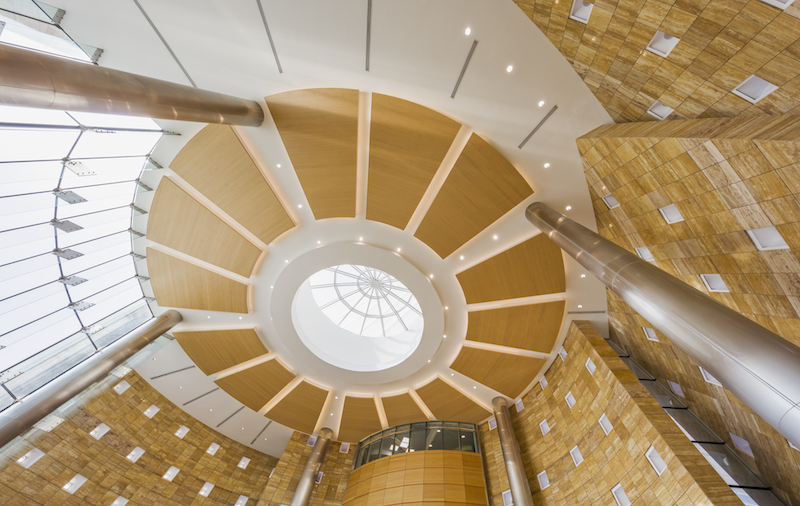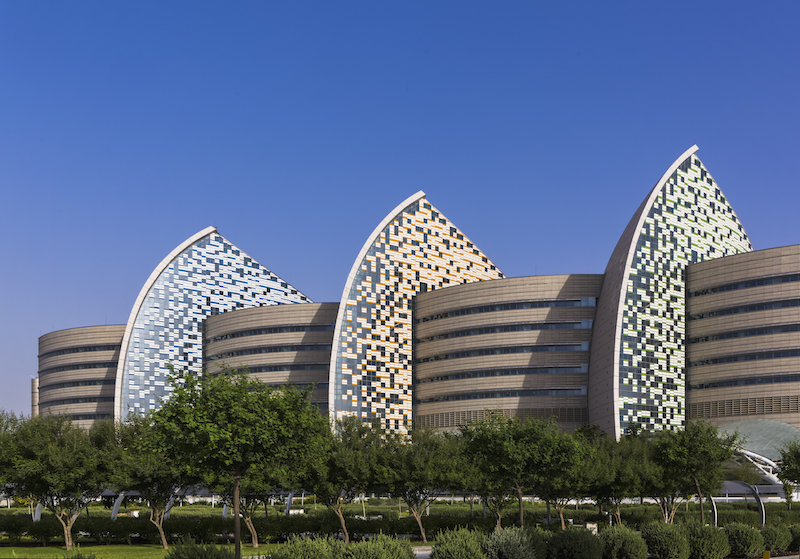This spring, the 1-million-sf Sidra Medicine in Doha, Qatar, is scheduled to launch a purpose-built clinic with in vitro fertilization services for reproductive consultation.
The hospital, which had its official opening on November 12, is one of the few in Qatar offering health services specifically for women and children. The facility, whose nearly $8 billion construction cost was endowed by Qatar Foundation, has more than 50 outpatient clinics and 400 inpatient beds, expandable to 550.
The hospital’s exterior design, by New Haven, Conn.-based Pelli Clarke Pelli Architects, is distinguished by three sails that take their cue from traditional boats known as dhows, and from sand patterns in Doha “that are quite beautiful,” says Mark Shoemaker, a Principal with Pelli Clarke Pelli. “These fluid forms inspired us.”

The hospital has three massive atriums, bathed in natural light. Image; Jeff Goldberg_Esto
The sails, clad in white ceramic tile, are part of massive atriums within the building, one of which includes a garden respite. The hospital also has a mosque, an ambulatory care center, and underground parking for 1,000 cars.
The medical center is positioned as a gateway to Education City, Doha’s 1.4-square-kilometer concentration of academic, science, and sports facilities. A tunnel connects the hospital directly to Cornell Weill Medical School, one of six campuses at Education City. (Other campuses are for Texas A&M, Carnegie Mellon University, and Virginia Commonwealth.)
The construction of Education City, which debuted in 1997, and Sidra Medicine was spearheaded by Sheikha Moza bint Nasser, chairperson of Qatar Foundation and consort to Sheikh Hamad bin Khalifa Al Thani, Qatar’s former Emir. Her Highness has been instrumental in advancing education and social reform in her country.
Shoemaker says Pelli Clarke Pelli was brought into the project by AECOM. (He once worked for Ellerbe Beckett, which designed the first Mayo Clinic. That firm is now part of AECOM). The team unveiled its design for Sidra Medical in 2007, and construction began in 2010.
Completion of the hospital was originally slated for 2011, and then 2015. The delays, explains Shoemaker, were partly attributable to the building’s size and complexity, but also to Building Team-related changes.
The hospital employs more than 4,000 people with 85 nationalities. Image: Sidra Medical and Research Center.
At one point AECOM left the project that then switched to a design-build delivery method led by Spain-based general contractor OHL, which had been in a joint venture with Contrack International for this project since 2008. Qatar Foundation fired OHL over delays in 2014, and OHL subsequently sued the foundation. Eventually, AECOM came back into the picture.
Sidra Medicine actually has been receiving patients since January 2018, and has staggered the opening of different departments—like robotic surgery last July. Shoemaker suggests this could be because Qatar doesn’t have enough trained medical professionals to meet the needs of such a large facility, and Sidra Medical has had to fill those gaps by recruiting (with Cornell Weill’s assistance) medical personnel from outside the country, mostly the United States and Europe.
When asked what his firm took away from this project, Shoemaker says that “it gave us the opportunity to experiment with different healthcare models for rooms and lobbies.” He adds that the design also paid attention to reflect Qatar’s culture.
Related Stories
| Aug 11, 2010
Gensler, HOK, HDR among the nation's leading reconstruction design firms, according to BD+C's Giants 300 report
A ranking of the Top 100 Reconstruction Design Firms based on Building Design+Construction's 2009 Giants 300 survey. For more Giants 300 rankings, visit http://www.BDCnetwork.com/Giants
| Aug 11, 2010
RSMeans/RCD forecast 14% drop in hospital construction for 2009
RSMeans forecasts a 14% drop in hospital construction in 2009 compared to 2008, with $17.1 billion in registered hospital projects as of June 30, 2009. The Reed Construction Data unit finds renovation of healthcare facilities increasing, from 36% of projects in 2008, to 40% of projects in the pipeline in the first six months of 2009.
| Aug 11, 2010
ASHRAE introduces building energy label prototype
Most of us know the fuel efficiency of our cars, but what about our buildings? ASHRAE is working to change that, moving one step closer today to introducing its building energy labeling program with release of a prototype label at its 2009 Annual Conference in Louisville, Ky.
| Aug 11, 2010
10 tips for mitigating influenza in buildings
Adopting simple, common-sense measures and proper maintenance protocols can help mitigate the spread of influenza in buildings. In addition, there are system upgrades that can be performed to further mitigate risks. Trane Commercial Systems offers 10 tips to consider during the cold and flu season.
| Aug 11, 2010
McCarthy, Skanska among nation's largest healthcare contractors, according to BD+C's Giants 300 report
A ranking of the Top 50 Healthcare Contractors based on Building Design+Construction's 2009 Giants 300 survey. For more Giants 300 rankings, visit http://www.BDCnetwork.com/Giants
| Aug 11, 2010
AECOM, Arup, Gensler most active in commercial building design, according to BD+C's Giants 300 report
A ranking of the Top 100 Commercial Design Firms based on Building Design+Construction's 2009 Giants 300 survey. For more Giants 300 rankings, visit http://www.BDCnetwork.com/Giants
| Aug 11, 2010
Payette completes Penn State Hershey Cancer Institute
Payette, a leading architectural design firm specializing in complex buildings for medical and scientific research, academic teaching, and healthcare, announced today the Penn State Hershey Cancer Institute ribbon-cutting and dedication ceremony was held on June 26, 2009. The new 176,000 square foot Cancer Institute is located on the Penn State Milton S. Hershey Medical Center Campus in University Park, Pa.







